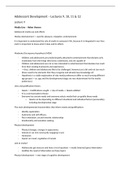Notes de cours
College aantekeningen Adolescent Development (lecture 9, 10, 11, 12)
- Cours
- Établissement
The latest lectures for the course Adolescent Development have been put together in this document. It includes the information of the slides, as wel as the information that the lecturers gave during the lectures. It contains lectures 9, 10, 11 and 12.
[Montrer plus]












